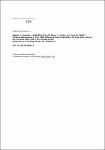Virulence Determinants of Avian H5N1 Influenza A Virus in Mammalian and Avian Hosts: Role of the C-Terminal ESEV Motif in the Viral NS1 Protein
Zielecki, Florian
Semmler, Ilia
Kalthoff, Donata
Voss, Daniel
Mauel, Susanne
Gruber, Achim D.
Beer, Martin
Wolff, Thorsten
We assessed the prediction that access of the viral NS1 protein to cellular PDZ domain protein networks enhances the virulence of highly pathogenic avian influenza A viruses. The NS1 proteins of most avian influenza viruses bear the C-terminal ligand sequence Glu-Ser-Glu-Val (ESEV) for PDZ domains present in multiple host proteins, whereas no such motif is found in the NS1 homologues of seasonal human virus strains. Previous analysis showed that a C-terminal ESEV motif increases viral virulence when introduced into the NS1 protein of mouse-adapted H1N1 influenza virus. To examine the role of the PDZ domain ligand motif in avian influenza virus virulence, we generated three recombinants, derived from the prototypic H5N1 influenza A/Vietnam/1203/04 virus, expressing NS1 proteins that either have the C-terminal ESEV motif or the human influenza virus RSKV consensus or bear a natural truncation of this motif, respectively. Cell biological analyses showed strong control of NS1 nuclear migration in infected mammalian and avian cells, with only minor differences between the three variants. The ESEV sequence attenuated viral replication on cultured human, murine, and duck cells but not on chicken fibroblasts. However, all three viruses caused highly lethal infections in mice and chickens, with little difference in viral titers in organs, mean lethal dose, or intravenous pathogenicity index. These findings demonstrate that a PDZ domain ligand sequence in NS1 contributes little to the virulence of H5N1 viruses in these hosts, and they indicate that this motif modulates viral replication in a strain- and host-dependent manner.
No license information
Related Items
Show related Items with similar Title, Author, Creator or Subject.
-
2011-10-19ZeitschriftenartikelGrowth of influenza A virus is not impeded by simultaneous removal of the cholesterol binding and acylation sites in the M2 protein Thaa, Bastian; Tielesch, Claudia; Möller, Lars; Schmitt, Armin O.; Wolff, Thorsten; Bannert, Norbert; Herrmann, Andreas; Veit, MichaelInfluenza virus assembly and budding occur in the 'budozone', a coalesced raft domain in the plasma membrane. The viral transmembrane protein M2 is implicated in virus particle scission, the ultimate step in virus budding, ...
-
2009-06-12ZeitschriftenartikelInfluenza B virus ribonucleoprotein is a potent activator of the antiviral kinase PKR Dauber, Bianca; Martinez-Sobrido, Luis; Schneider, Jana; Hai, Rong; Waibler, Zoe; Kalinke, Ulrich; Garcis-Sastre, Adolfo; Wolff, ThorstenActivation of the latent kinase PKR is a potent innate defense reaction of vertebrate cells towards viral infections, which is triggered by recognition of viral double-stranded (ds) RNA and results in a translational ...
-
2011-11-18ZeitschriftenartikelSynergistic Adaptive Mutations in the Hemagglutinin and Polymerase Acidic Protein Lead to Increased Virulence of Pandemic 2009 H1N1 Influenza A Virus in Mice Seyer, Roman; Hrincius, Eike R.; Ritzel, Dorothea; Abt, Marion; Mellmann, Alexander; Marjuki, Henju; Kühn, Joachim; Wolff, Thorsten; Ludwig, Stephan; Ehrhardt, ChristinaInfluenza impressively reflects the paradigm of a viral disease in which continued evolution of the virus is of paramount importance for annual epidemics and occasional pandemics in humans. Because of the continuous threat ...

